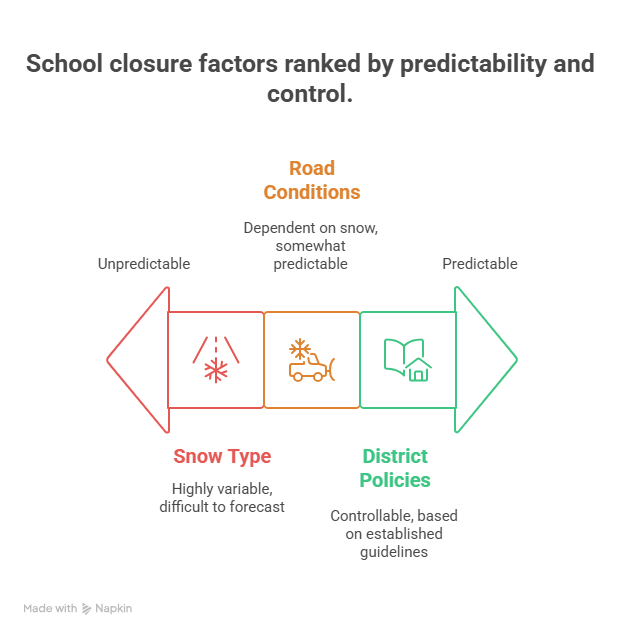School Closing Predictions: The Most Accurate Guide for Snow Days in West Michigan
As winter tightens its grip, snow day buzz fills the air. But instead of guessing, modern snow day predictions are powered by technology, local insights, and data-driven forecasting tools. This guide goes beyond generic tools like SnowDayCalculator.com and offers localized insight for West Michigan, a region uniquely impacted by lake-effect snow.
We’re not just reviewing tools we’re diving into how they work, why they matter, and how families, schools, and districts can make smarter decisions this winter.
What Is a Snow Day Calculator and Why It Matters
A snow day calculator predicts the chance of school closures based on weather data and local criteria. Unlike the competitor articles that briefly define it, we dig deeper into how they can be trusted and what truly influences their output.
Key inputs include:
- Snow accumulation & timing
- Wind chill and freezing rain
- Local school district policies
- Historical weather and closure patterns
The Science Behind Accurate School Closing Predictions
Competitors focus heavily on weather inputs but we add depth by explaining how predictive accuracy is achieved.
3 Core Data Layers Used in Smart Calculators:
1. Real-Time Weather API Feeds: Snowfall totals, wind speed, temperature trends.
2. Machine Learning Algorithms: Trained on closure patterns over years of school data.
3. Geolocation-Specific Customization: Different rules for a Chicago suburb vs. a rural Michigan town.
Unlike most calculators, the best ones learn over time. They evolve with your region’s response history not just snowfall totals.
Why West Michigan Needs Specialized Predictions
Generic calculators treat all snow the same. But West Michigan’s lake-effect snow, hilly terrain, and rural roads make closures more complex. Here’s what others skip:
Historical Snow Day Trends
> Cities like Grand Rapids and Kalamazoo average 8–12 snow days annually.
> Closures often align with wind gusts and freezing rain more than snowfall.
Local Decision-Making Logic
> Superintendents rely on pre-commute road checks, bus routes, and staff availability.
> Districts may close even when snow totals are low but wind chills or ice are dangerous.

Key Factors That Influence School Closures
Instead of listing conditions vaguely, we prioritize how they interact, especially in local contexts:
Snow Type and Timing
❄️ Wet, heavy snow + AM commute = high closure chance
❄️ Light snow post-8AM = likely to stay open
Road & Bus Conditions
❄️ Rural roads freeze faster leading to preemptive closures in outlying districts
❄️ Bus travel risk outweighs classroom schedule consistency
District Policies & Risk Thresholds
❄️ Some schools close at 4 inches of snow, others wait for 6+
❄️West Michigan districts often factor in staff commute distances
Top Snow Day Prediction Tools Compared
Instead of just reviewing tools, we evaluate how useful they are specifically for West Michigan users.
|
Tool |
Best For |
Limitations |
|---|---|---|
|
SnowDayCalculator.com |
Quick national forecast |
Lacks detailed local inputs or custom logic |
|
SnowDayPredictor.com |
Basic school-specific data |
Not ideal for rural conditions |
|
AI Snow Tracker (Beta) |
Smart prediction learning |
Limited public access |
|
Local News Apps (e.g. WOOD TV8) |
Real-time road alerts |
No predictive element, just reporting |
✅ Tip: Use a combo start with a calculator, then confirm with local radar and district text alerts.
How Parents & Schools Should Act on Predictions
A major weakness of competitor content is it stops at explanation. We go further by telling users what to do with the predictions.
1. Parents: Prep Checklist
- Set up school/district SMS alerts
- Follow local meteorologists (not just apps)
- Keep backup childcare options flexible during storm windows
2. Schools: Proactive Protocol
- Use radar-connected alert systems (e.g., SwiftK12, Remind)
- Automate early decision emails and voicemail blasts
- Consider hybrid prep days when forecasts are borderline
Myth vs. Reality: Common Misconceptions About Snow Days
Competitors don’t challenge assumptions we do.
|
Myth |
Reality |
|---|---|
|
If there’s snow, school will close. |
Not always road safety is more critical than snow depth. |
|
Calculators are always right |
They’re just probabilities, not guarantees. |
|
All schools in a region close together. |
Neighboring districts often make separate decisions. |
Why This Guide Beats the Basics
Unlike the general “ultimate guides,” this article is:
1.Localized for West Michigan
2. Actionable for both parents and school officials
3. Deeper in explaining predictive logic and planning
3. Smarter about using multiple data points, not one tool
Conclusion
Snow day predictions aren’t just about curiosity, they’re about safety, planning, and trust in data. While national calculators offer a helpful starting point, they fall short when it comes to local nuance, especially in regions like West Michigan, where lake-effect snow and unpredictable terrain can change everything.
By combining technology (calculators, alerts, radar apps) with human insight (school policies, road conditions, regional weather history), this guide empowers you to make smarter, more confident decisions, not just hopeful guesses.
So next time the flakes start falling, don’t rely on guesswork. Rely on data, context, and preparation, and let this guide be your winter-weather blueprint.
